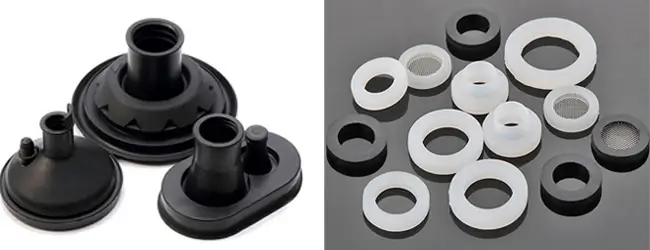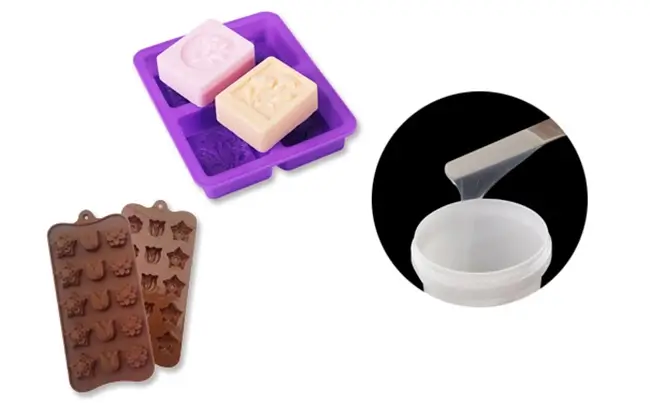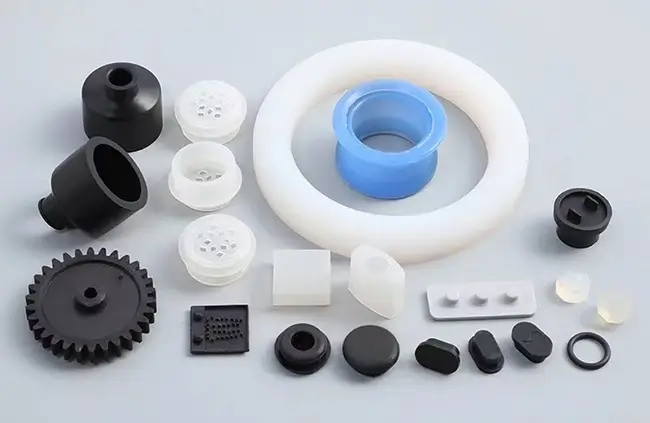In terms of silicone and natural rubber materials, factors such as toughness, softitude (sensibility), heat resistance and chemical protection have to be considered. So this article gives you a detailed comparison that will help you make the right choice for your particular needs.
Understanding the Composition and Materials
Knowing the makeup and materials of printed circuit boards (PCBs) is important for designing robust electronic systems. Generally speaking, PCBs are made up of layers of fiberglass-reinforced epoxy resin (FR4) for a stable base. These layers are laminated with copper foil to form conductive traces, providing the basic structure for precise and structured electric circuits in electronic goods.
What is Rubber?

Rubber is an elastic polymer derived from the latex sap of certain plants or created synthetically out of petroleum-based compounds. Its structure is a chain, that stretches and then returns to its shape. Rubber, which comes from the tree of rubber and synthetic rubber made through chemical processes are widely employed in numerous industries. Rubber is a remarkably versatile material, with properties of elasticity, imperviousness and insulation making it essential in the manufacture or tires; gaskets; hoses etc., as well as many consumer goods.
What is Silicone Rubber?
Silicone rubber is one kind of synthetic rubber made from silicon, oxygen, carbon and hydrogen. It is remarkably temperature resistant–flexible and elastic even from extremely low to high temperatures.

Because silicone rubber is an excellent electrical insulator and resistant to all kinds of weathering, as well as being compatible with numerous different chemicals. These will make silicone rubber a very popular choice in many applications, not only gaskets and seals but also medical devices instruments plastics kitchenware packaging electrical insulation where its stability is particularly valuable.
Is silicone and rubber the same thing?
No. Silicone and rubber are not one in the same. The word rubber is rather non-specific, and anyone can be a rubber voter as long as you’re going to vote anyhow. On the other hand, silicone is a special kind of synthetic rubber derived from the elements: silicon, oxygen.

Natural rubber, known as polyisoprenes, comes naturally out of the rubber plant. Silicone, however, is synthetic. Although both materials have different properties the materials are elastomers.
Silicone rubber and thermoplastic are both flexible, resilient materials. However, silicine has the unique property of good heat resistance; it is a superior insulator electrically speaking (thermoplastics do not have this characteristic), possesses superb weather-resistant properties as well as excellent ability to age in place. It differs from other types of rubber.
What is the Difference Between Rubber and Silicone?
Rubber and silicone are different materials with a difference in composition and properties.

Rubber is a common name for elastic materials. Silicone, however, are those synthetic rubbers which contain silicon (Si), oxygen (O), carbon(C) and hydrogen (H) fragments. Silicone is remarkable for its temperature resistance, which allows it to retain flexibility over a wide range of temperatures. Its electrical resistivity and insulating property are also outstanding good resistance other chemicals.
In light of all this, silicone is especially popular for uses that require high temperature stability and excellent electrical insulation; it can be found in many medical devices as well as electronics.
Silicon, however, exhibits higher chemical resistance compared to other materials, thus providing better sealing properties. It will depend upon the exact chemicals that are going to enter the environment.
Is silicone rubber of plastic?

Silicone is a plastic polymer but sometimes called synthetic rubber, in other words. But there is much simpler than this. Polysilicane silicone polymers are polymers of siloxane. Colourless oil and rubber compounds are commonly used.
How do you know if it is silicone or rubber?
Determining if something is silicone or rubber tree often depends on its special features.
While silicone generally has a smoother and shinier surface than rubber, which is more textured in its appearance. What’s more, silicone is softer and more pliant; it holds its elasticity over a wider temperature range.

Rubber has its own distinctive odor, but silicone generally is neutral to the nose. But the best way to tell is by checking product labels (often they specifically say if a given item is silicone or rubber), and specifications.
4 Types of Silicone and Their Differences
The major categories of silicone-High—Temperature Vulcanized (HTV) Silicone, Liquid Silicone Rubber(LSR), Room Temperature vulcanizing
1. High-Temperature Vulcanized (HTV) Silicone:
HTV silicone, heat cured and filler reinforced is good at high-temperature resistance and can be used in industry or cars.
2. Liquid Silicone Rubber(LSR)
LSR, a liquid compound cured with heat, is flexible and biocompatible. It’s suited to applications such as medical devices or automotive components.
3. Room Temperature vulcanizing
RTV silicone, curing with a room temperature catalyst at normal room temperatures is convenient to use and used in sealants, adhesives etc.
4. Fluorosilicone Rubber (FSR)
FSR, incorporating fluorine atoms, is more resistant to chemicals and of great value in aerospace or military applications where encountering harsh substances are very common.
What is the difference between rubber and silicone sealant?
The differences between rubber and silicone sealants lie in their makeup and characteristics.

Silicon, however, exhibits higher chemical resistance compared to other materials, thus providing better sealing properties. It will depend upon the exact chemicals that are going to enter the environment.
Rubber sealants usually employ polymers of synthetic or natural rubber, providing flexibility and adhesion.
Silicone sealants however are silicon-based polymer products. These have excellent temperature resistance, weatherability and superior flexibility among characteristics. Silicone sealants are recognized for their longevity properties, resistance to UV rays and very good quality over a wide temperature range. Although both are effective sealants, the choice between rubber and silicone is specific to application requirements e.g., high-temperature resistance; weatherproofing or need for flexibility.
What Are the Other Forms of Silicone?
Besides silicone rubber, there are also many different kinds of silicones made to suit particular uses. Because silicone fluids of different viscosities are heat stable, they serve as lubricants and hydraulic fluids.
Silicone gels
Silicone gels, made by cross-linking silicone fluids, are used as dampers and in medical applications.
silicone resins
Highly cross-linked polymers in a resin form, silicone resins serve as protective coatings and encapsulants. In high-temperature applications they are particularly useful.
silicone elastomers
Medical devices and flexible part making frequently use silicone elastomers–flexible, elastic silicon materials.
silicone foams
Finally, for their lightweight and flexible properties, silicone foams with a foaming agent are used in gaskets, seals and insulation.
What is silicone rubber used for?

Silicone rubber is widely used for automotive applications, in cooking and baking and in food storage products. Its unique set of properties makes silicone rubber a versatile material which finds use in many different industries. This material is highly flexible, and resists extremes of temperature plus weathering as well as UV radiation; it has a wealth of applications. In the automotive industry, silicone rubber is employed in gaskets and seals as well as hoses because it resists both heat and chemicals. Electronics: a basic material for insulating and protecting components.
it is biocompatible, the medial industry uses silicone rubber in medical devices and prostheses. It also has uses in kitchenware, construction and consumer goods because it is durable and can be easily molded into complex shapes. Because of these characteristics, silicone rubber is widely used in the design and manufacture of reliable products which last a long time.
What is cheaper silicone or rubber?(9)

Silicone is less pricey than most rubbers and is made from high performing Polymer. It is generally in relatively small quantity requiring specialized and highly complex production processes.
In particular, rubber is usually more economical than silicone. Despite being more costly to produce, natural rubber (obtained from the latex sap) and synthetic rubbers made with petroleum-based compounds are widely used for a variety of purposes. With special properties, such as high-temperature resistance and toughness, silicone is a synthetic rubber whose price usually costs more than natural latex.
The cost difference between the two materials depends on factors such as manufacturing processes, raw material costs and specific properties needed for a given application. But although rubber is often selected because it’s cheap, the better characteristics of silicone render it the preferred option in all those uses where its basic attributes are needed. It doesn’t come cheap however – there is a high price to pay for quality and performance!
Is Silicone a Type of Rubber?
Yes, silicone is a kind of rubber; it’s actually a synthetic rub It is a silicon-oxygen-carbon-hydrogen polymer. What makes silicone different from ordinary rubber, however, is its special chemical makeup and excellent performance. It has high-temperature resistance, flexibility across a wide temperature range, good electrical insulation property and is resistant to weathering and aging.
Because of these unique characteristics, silicone has become the ideal choice for applications where traditional rubber falls short. Although is categorized alongside rubber, silicone differentiates itself by its special characteristics which allow it to be used in a wide variety of industrial and commercial applications.
Is Liquid Rubber the Same as Silicone?
No, liquid rubber is not the same as silicone. Both are used as sealants and coatings, however. A liquid polymer formed from natural or synthetic rubber is usually what we mean by liquid rubber. For its flexibility and durability it is widely used for waterproofing as well as protective coatings.
Rubber Gaskets
Rubber gaskets are critical components used to produce a tight seal between two surfaces, preventing the escape of liquefied or gasified substances. These gaskets are usually of natural rubber or synthetic rubber compounds. They have excellent elasticity and flexibility. Their ability to conform themselves to irregularities in the surface guarantees that they make a tight, effective seal, so you will see them anywhere from cars and pipes down through appliances. Rubber gaskets not only seal joints, connections and openings, but also help maintain both the working efficiency of mechanical systems while maintaining their structural integrity.
Silicone Gaskets
Silicone gaskets are sealing components made from silicon rubber, a synthetic polymer constructed of the elements silicon, oxygen carbon and hydrogen. These gaskets have a number of special properties that make them ideal for many different applications. With its remarkable flexibility, elasticity and ability to withstand extremes of temperature, silicone gaskets enable dependable seals. They are frequently used in the automotive, electronics and food processing industries. In these applications, gaskets must be capable of withstanding a heat range while providing an effective seal. The characteristics of silicone also make these gaskets suitable for uses where UV resistance, weathering and electrical insulation are required.
Summary
It depends on the particular needs of an various applications whether it is silicone or natural rubber with original dimensions. Silicone offers high heat resistance, good flexibility and excellent dielectric properties, elastomer; it is therefore suitable for areas like electronics, medical equipment or extreme higher temperatures environments. On the other hand, natural rubber is cheaper in value and features outstanding elasticity. Therefore it’s more practical for applications where flexibility as well as general sealing performance are important requirements, such gaskets and industrial use Temperature, cost and special properties of the material are all crucial considerations when deciding whether silicone or natural rubber is better for a particular application and the depend on the better performance have Although both materials have different properties the materials are elastomers some of them have styrene butadiene rubber tree, mechanical properties, silicone rubbers, silicon atoms you can see also if its either in rubber or in the silicone which have abrasion resistance, their physical and mechanical properties, their medical devices which you can use it, in silicone polymer chains were you can use it in the silicone sealants or bonding agents/ silicone oxygen bond, nitrile rubber, or oxygen atoms, you can also use in the injection molding were you can see it their production process.